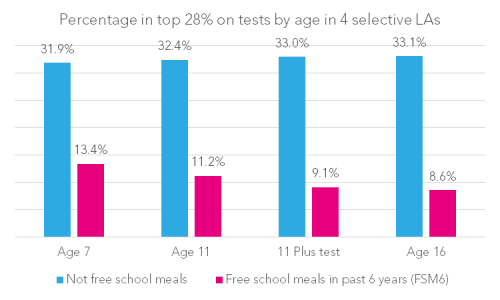Academic selection into separate schools tends to polarise commentators into those that think it is acceptable and those who think it is wrong. And yet most people agree that selection is acceptable at 18 and wrong at age 4. So the point of contention is surely what the right age to allow academic selection is.
The problem with academic selection at a very young age is not just that the deleterious effects of social separation and longer journeys to school feel particularly harsh. It also results in high levels of misclassification since we cannot devise cheap and effective tests to measure academic potential in the young. Indeed, the role of measurement error was the source of fierce controversy in how social class impacts on early cognitive development between Feinstein, who claimed that high ability children from low social class backgrounds end up performing worse than low ability children from high social class backgrounds, and Jerrim/Vignoles, who contended that the data was equally consistent with greater error in measuring ability accurately for the very young.
A significant group of pro-selection supporters believe that age 11 is too early to separate children into different institutions and have advocated the introduction of later selection at age 13 or even in waves of selection from age 11 onwards. They are in good company. Michael Barber writes in his wonderful book on The Making of the 1944 Education Act that most supported academic selection at age 13 or 14, but it was pushed down to 11 by the churches who couldn’t afford to provide an education beyond age 11 in their existing elementary schools.
Of course, deferring academic selection seems so much less harsh. But it does nothing to help ensure that those from the poorest backgrounds attend grammar schools. Indeed, it is likely to do the opposite. In the chart below we identify the top 28% of the attainment distribution on the Key Stage tests at ages 7, 11 and 16 for all those (with complete test score data) attending schools in Kent, Medway, Buckinghamshire and Lincolnshire. The later the test is deferred, the fewer children from disadvantaged backgrounds are likely to pass.

It isn’t possible to say why this pattern emerges. Greater measurement error in earlier tests, differences in school quality and home inputs, tutoring and even the strengthening impact of genetics may all contribute.
The difference in success of pupil premium children on the age 11 SATs versus the 11 plus entrance test is noteworthy, but it certainly doesn’t measure the impact of tutoring for the test amongst higher income families. This is because tutoring almost certainly raises SATs scores in selective LAs. (Indeed, whether or not selection affects primary school progress was the topic of interesting debate between Manning/Pischke and Galindo-Rueda/Vignoles.) In fact, 11 plus tests and SATs measure quite different academic competencies and so there is no reason why different groups of pupils should perform equally well or badly on both.






Leave A Comment